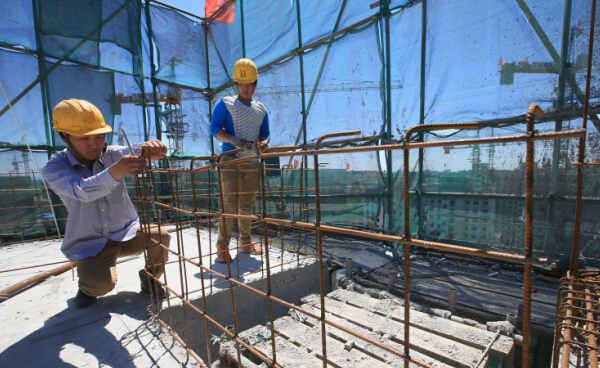Many benefits of a grand plan for affordable housing
Updated: 2015-07-21 07:55
By Fu Jing(China Daily)
|
||||||||
 |
|
Workers proceed with the roof-capping work of affordable housing project in Beijing's Shunyi district on May 20, 2014. [Photo by Fu Ding/Asianewsphoto] |
The Chinese government has recently announced two surprisingly encouraging figures on the construction of housing to meet the needs of those living on the lower rungs of the social ladder.
Last year, China announced that it will have constructed about 40 million welfare apartments from 2011 to 2015, surpassing its previous target of 36 million for the five years. The construction pace has been greatly accelerated, compared with the total of 15 million such apartments built during the period from 2006 to 2010.
The Chinese government said it had also renovated 21 million dilapidated houses in the "rust belts" of old industrial cities and the "villages in the cities" nationwide by the end of 2014. And it will continue such efforts by renovating 18 million such apartments over the next two years.
The government has now been busy setting its targets for 2016 to 2020. And here it could perhaps learn from Sweden by setting the goal of providing cheap or free housing to a significant portion of the country's population.
In the period 1965 to 1974, the Swedish government announced its "Million Program", in which it built 1,006,000 apartments to ensure that middle-and low-income Swedish families could have affordable homes. This meant, over the 10 years, the Swedish government provided cheap or free housing to nearly half of the country's population.
Such an ambition can be a meaningful reference for Chinese policymakers. Based on the previous progress, it is still feasible for Chinese government to announce a "200 million program" by 2025, which means that within 20 years from 2006, China could build or renovate 200 million affordable or free houses for its needy citizens.
And if China sustains its relatively fast pace of economic growth, it can even set an ambitious target of announcing it will offer 300 million affordable apartments by around 2030.
Realizing such a plan would also produce a number of other desirable outcomes.
First, it would help further cool the overheated property prices in China, which could inject fresh impetus into the gloomy housing market.
And of course, building millions of affordable houses will create long chain of opportunities for economic growth and jobs. Although considering the ills that have arisen as a result of China's rapid urban expansion over the previous 10 to 20 years, the building needs to be kept at an acceptable pace.
The government could also consider purchasing the "ghost towns", those residential developments that mushroomed during the housing boom that have never been lived in, and even some unfinished projects from those developers who are going bankrupt, to save resources and lands. China has experienced a hectic decade in real estate development and this could help rationalize the market.
The Chinese government can also bear its rapid demographic change in mind, and not only meet the needs of families and those moving from the rural regions to cities, but also put the needs of aging people on agenda.
This is actually quiet urgent. China has more than 137 million people aged above 65, or nearly ten percent of its total. But, according to official statistics, homes for the elderly could only offer 5.5 million beds nationwide by the end of 2014.
And just as important, China would have to train millions of professional management and service staff to meet the demands of handling public properties for the needy and old people.
However, to ensure such housing fulfilled its purpose, the government should carefully allocate the affordable apartments so they only go to those they are intended for. At the very beginning, some local governments lost their credibility by selling affordable apartments to people who were clearly not in need.
The author is deputy chief of China Daily European Union Bureau fujing@chinadaily.com.cn
- Global health entering new era: WHO chief
- Brazil's planning minister steps aside after recordings revelation
- Vietnam, US adopt joint statement on advancing comprehensive partnership
- European border closures 'inhumane': UN refugee agency
- Japan's foreign minister calls A-bombings extremely regrettable
- Fukushima impact unprecedented for oceans: US expert

 Stars of Lijiang River: Elderly brothers with white beards
Stars of Lijiang River: Elderly brothers with white beards
 Wealthy Chinese children paying money to learn British manners
Wealthy Chinese children paying money to learn British manners
 Military-style wedding: Fighter jets, grooms in dashing uniforms
Military-style wedding: Fighter jets, grooms in dashing uniforms
 Striking photos around the world: May 16 - May 22
Striking photos around the world: May 16 - May 22
 Robots help elderly in nursing home in east China
Robots help elderly in nursing home in east China
 Hanging in the air: Chongqing holds rescue drill
Hanging in the air: Chongqing holds rescue drill
 2.1-ton tofu finishes in two hours in central China
2.1-ton tofu finishes in two hours in central China
 Six things you may not know about Grain Buds
Six things you may not know about Grain Buds
Most Viewed
Editor's Picks

|

|

|

|

|

|
Today's Top News
Liang avoids jail in shooting death
China's finance minister addresses ratings downgrade
Duke alumni visit Chinese Embassy
Marriott unlikely to top Anbang offer for Starwood: Observers
Chinese biopharma debuts on Nasdaq
What ends Jeb Bush's White House hopes
Investigation for Nicolas's campaign
Will US-ASEAN meeting be good for region?
US Weekly

|

|









